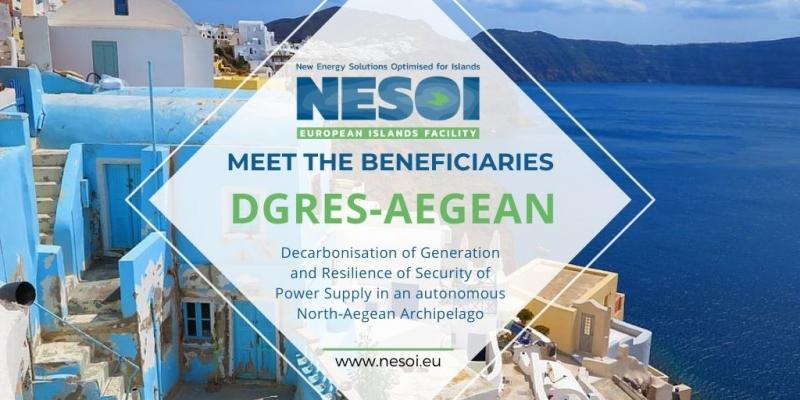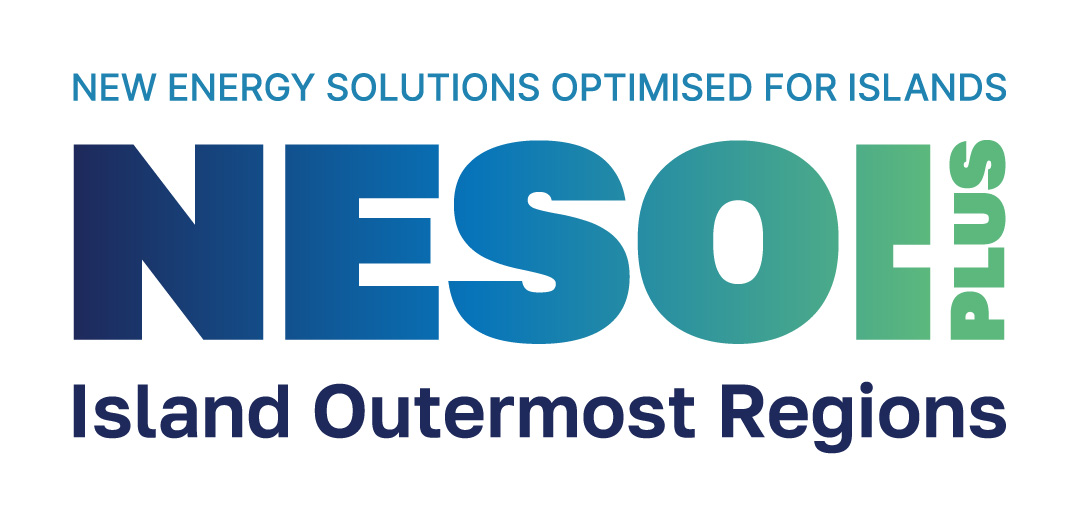Decarbonization of Generation and Resilience of Security of Power Supply in an autonomous North-Aegean Archipelago (DGRES-AEGEAN) is a project supported by NESOI European Islands Facility, managed by our partners from CERTH, and promoted by the Network of Sustainable Greek Islands (DAFNI) Public Power Corporation S.A.
What is DGRES-AEGEAN?
The main aim of the project is to take decisive steps toward the decarbonization of the system’s electricity generation and the improvement of the resilience of security of electricity supply to the Archipelago.
The DGRES-AEGEAN project's goals are to contribute to raising the proportion of renewable energy in the island systems, boost the thermal plant's energy effectiveness, and enhance supply quality and network resilience. Photovoltaics and batteries are examples of mature, commercially available technologies that were required to achieve these goals. Also, by meeting the electrical needs of 130 energy-poor households, the establishment of an energy community will aid in the drive to combat energy poverty.
The islands considered for this project, in more detail, are Chios, Psara, and Oinousses. First, the Chios project offers the following technologies: the installation of two hybrid PV-powered systems, the substitution of conventional diesel with renewable diesel, and the deployment of a behind-the-meter battery energy storage system in the thermal power station. Also, Psara & Oinousses want to provide free electricity to low-income residents as part of the implementation of hybrid systems powered by solar energy on each island.
Therefore, replicates of the project are expected to have substantial benefits to the whole clean energy transition of the Greek islands. Another 28 isolated island electricity systems with similar characteristics exist in Greece. The role of the GDRES-AEGEAN’s promoters is critical since PPC is the major (or sole) electricity producer in Greek islands and DAFNI represents a significant share of island municipalities.
The multiple use cases of energy storage
The energy system must incorporate storage capabilities to make up for the rising levels of intermittent renewable energy output, especially in the systems of tiny islands. The fact is that storage systems have a variety of capacities, giving them the opportunity to offer a wide range of services at various levels of the energy system and over a variety of timeframes, which in turn creates a number of value streams.
For example, network operators can employ energy storage to maintain the network's ongoing functioning (frequency regulation, congestion management), and even to postpone some expenditures in new network assets. Renewable energy producers can also utilize it to streamline their output and prevent interruptions. Also, it can assist in improving the performance of thermal power plants.
This variation is very clearly illustrated by the batteries that will be placed as part of the DGRES-AEGEAN project in Chios, Oinousses, and Psara.
Expected energy savings
The total expected primary energy savings from the whole project amount to 174,647 MWh/yr, while the total CO2 emission savings are 106 ktonCO2eq as the island complex is going to be fully decarbonized with the help of renewable diesel substitution. 10.6 MWp of PVs and 85.6MWh of storage.
How does NESOI Support this project?
The European Islands Facility NESOI aims to unlock the potential of EU islands to become the locomotives of the European Energy Transition. To do so, NESOI aims to mobilize more than €100 Million of investment in sustainable energy projects to give EU islands the opportunity to implement energy technologies and innovative approaches, in a cost-competitive way. NESOI has selected 56 such projects across the European Union and provide them with financial resources and technical support.
NESOI helps the DGRES-AEGEAN project regarding both technical and financial aspects.
The main challenges faced are:
- Clarifying the regulatory framework when it comes to combining storage and power generation.
- Setting-up of energy community. The identification and selection of suitable participating households are challenging as there are sensitive data issues.
- Financing of the project.
More in specific, NESOI has provided the following support to this project:
- Identification of suitable technological options given existing project sizing requirements
- Definition of the required environmental permitting procedures
- Cost-Benefit, socio-economic and environmental analysis, and Identification of the preferred option and corresponding definition of project inputs.
- Risk analysis and identification of available mitigation strategies and Assessment of existing procurement options
- Analysis of the permitting procedures and contractual framework
- Financial modeling and identification of target scenario and Identification of financing/funding options.
- Identification of the preferred option and corresponding definition of project input
- Action plan and identification of project monitoring procedures
DOWNLOAD THE DEDICATED BROCHURE


